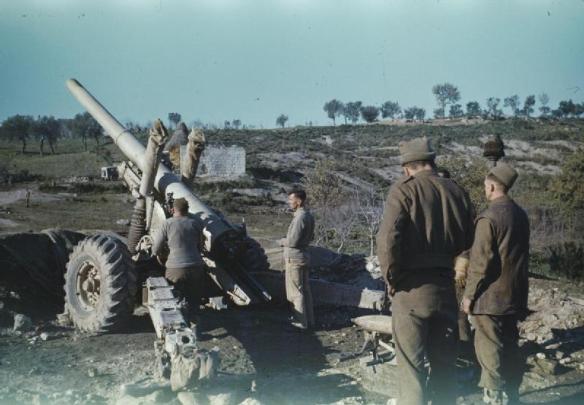BL 5.5-inch Medium Gun in Italy, 1944
A British 4.5 inch gun in Normandy, 1944
WW II Radar Counter battery fire
Counter battery fire most definitely was part of the WWII mortar crews concern hence the cover and protection. The allies had radar reserved specifically for this role. (First discovered by a bored 3.7 AA radar operator in Tunis watching Nebelwerfer rounds going up and coming down).
Failing that two soldiers in different locations taking compass bearings on the sound of the primaries going off or the smoke of the dentition is a tried and tested method. Site selection is therefore quite important. The 120mm had a minimum range of 300 meter and a maximum of 6025 meters so they would generally be sited 500 – 100 meters behind the main line of resistance depending on terrain.
#
Sir Brian Horrocks
This quote comes from “Corps Commander” by Sir Brian Horrocks, Methuen Books, 1977. Horrocks was in charge of XXX Corps of the British Army from D-Day to early 1945 and had earlier been a divisional commander in the Desert.
‘Since the war I have often paid tribute to the part our artillery played. The core of the Royal Artillery was the fantastic accuracy of their Survey Units. The one I knew best was a pre-war Territorial Unit, 4th (Durham) Survey Regiment from Gateshead. I first met them in the Middle East and we were then together until the end of the war and I came to rely on them completely, as will be seen form the account of the forthcoming battle. Neither the Germans nor the Russians, nor even the French, who were always supposed to be masters of artillery fire systems, could approach the accuracy or weight of concentrated fire power which, on my Corps front, I had at my disposal in a matter of minutes. To simplify and speed up the call for a concentration of artillery fire, only code-names were necessary. Thus, if I wanted the fire of all seventy-two 25-pounder field guns of any division to be concentrated on one target, my Gunner Brigadier (CCRA) would merely have to get in touch with the Brigadier RA at the division concerned and ask for an “Uncle” target to be fired. If a target was sufficiently important to warrant all, or most, of the Corps Artillery being employed, this was called a “Victor” target; this might involve 216 field guns from three divisions, and perhaps 128 medium and heavy (5.5-inch, 7.2-inch and 155-mm calibres) guns of two Army Groups RA, with four regiments each of 16 guns; in addition there would usually be on call at least forty-eight guns from two or more regiments of 3.7-inch heavy anti-aircraft guns firing high-explosive shells in a field role. In a matter of minutes, therefore, about 400 guns could be brought into action where I wanted them.’
#
The 60pdr was removed from service in 1941, when the barrels were rebored to 4.5″ calibre (114mm) and used as improvised 4.5″ Gun on new 4.5″/5.5″ gun carriage. By end of 1941 genuine ‘new’ 4.5″ Guns were in service and then in 1942 5.5″ (140mm) Howitzers were added. Medium Regiments could be either or mixed, 4.5″ generally for Counter Battery, 5.5″ for genuine barrage work. Meanwhile in 1940-41 old 6″ (152mm) Howitzers served alongside 60pdrs and later 4.5″ Guns, and in North Africa in 1942 old US 155mm “Chimney Pot” Howitzers equipped a couple of Regiments.
#
THE 4.5-INCH GUN MK2 AND THE 5.5-INCH GUN MK3
The British government accepted the 4.5-inch Gun Mk2 in 1939 and the 5.5-inch Gun Mk3 in 1941. The Mk3 was widely exported and remained in service as the standard British medium gun until 1980. It fired a 100-pound shell to a maximum range of 16,196 yards. The Mk3 was easily distinguished by tall vertical projections on either side of the tube housing springs to balance the barrel. Served by a crew of ten, it had a firing rate of 2 rounds per minute.
4.5-inch Gun Mk2
Adoption date: 1939
Caliber: 4.5-inch
Weight: 12,086 pounds
Breech: interrupted screw
Barrel length: 184.5 inches
Elevation: 45°
Transversal: 60°
Projectile weight: 55 pounds
Muzzle velocity: 2,247 fps
Maximum range: 20,500 yards
5.5-inch Gun Mk3
Adoption date: 1941
Caliber: 5.5-inch
Weight: 13,647 pounds
Breech: interrupted screw
Barrel length: 165 inches
Elevation: 45°
Traversal: 60°
Projectile weight: 100 pounds
Muzzle velocity: 1,673 fps
Maximum range: 16,196 yards
